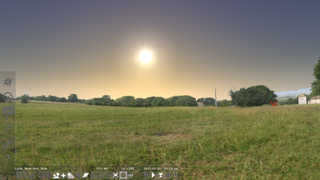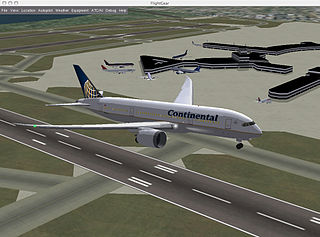
The Ames Research Center (ARC), also known as NASA Ames, is a major NASA research center at Moffett Federal Airfield in California's Silicon Valley. It was founded in 1939 as the second National Advisory Committee for Aeronautics (NACA) laboratory. That agency was dissolved and its assets and personnel transferred to the newly created National Aeronautics and Space Administration (NASA) on October 1, 1958. NASA Ames is named in honor of Joseph Sweetman Ames, a physicist and one of the founding members of NACA. At last estimate NASA Ames had over US$3 billion in capital equipment, 2,300 research personnel and a US$860 million annual budget.
KStars is a free and open-source planetarium program built using the KDE Frameworks. It is available for Linux, BSD, macOS, and Microsoft Windows. A light version of KStars is available for Android devices. It provides an accurate graphical representation of the night sky, from any location on Earth, at any date and time. The display includes up to 100 million stars, 13,000 deep sky objects, constellations from different cultures, all 8 planets, the Sun and Moon, and thousands of comets, asteroids, satellites, and supernovae. It has features to appeal to users of all levels, from informative hypertext articles about astronomy, to robust control of telescopes and CCD cameras, and logging of observations of specific objects.

The Space Telescope Science Institute (STScI) is the science operations center for the Hubble Space Telescope (HST), science operations and mission operations center for the James Webb Space Telescope (JWST), and science operations center for the Nancy Grace Roman Space Telescope. STScI was established in 1981 as a community-based science center that is operated for NASA by the Association of Universities for Research in Astronomy (AURA). STScI's offices are located on the Johns Hopkins University Homewood Campus and in the Rotunda building in Baltimore, Maryland.

Stellarium is a free and open-source planetarium, licensed under the terms of the GNU General Public License version 2 or any later version, available for Linux, Windows, and macOS. A port of Stellarium called Stellarium Mobile is available for Android, iOS, and Symbian as a paid version, being developed by Noctua Software. These have a limited functionality, lacking some features of the desktop version. All versions use OpenGL to render a realistic projection of the night sky in real time.

Celestia is a real-time 3D astronomy software program that was created in 2001 by Chris Laurel. The program allows users to virtually travel through the universe and explore celestial objects that have been catalogued. Celestia also doubles as a planetarium, but the user is not restricted to the Earth's surface, like in other planetarium software such as Stellarium. Celestia can display objects of various scales using OpenGL.

The Starlink Project, referred to by users as Starlink and by developers as simply The Project, was a UK astronomical computing project which supplied general-purpose data reduction software. Until the late 1990s, it also supplied computing hardware and system administration personnel to UK astronomical institutes. In the former respect, it was analogous to the US IRAF project.

HNSKY or Hallo Northern Sky is a free and open-source planetarium program for Linux, macOS, Microsoft Windows, and Raspberry Pi to simulate the night sky. It is provided with several non-English language modules, numerous astronomical catalogues, conversion utilities and tools, as well as several stellar databases.
The Space Telescope Science Data Analysis System (STSDAS) is an IRAF-based suite of astronomical software for reducing and analyzing astronomical data. It contains general purpose tools and packages for processing data from the Hubble Space Telescope. STSDAS is produced by Space Telescope Science Institute (STScI). The STSDAS software is generally in the public domain, however some routines were taken from the Numerical Recipes and other books and cannot freely distributed.

NASA's Independent Verification & Validation (IV&V) Program was established in 1993 as part of an agency-wide strategy to provide the highest achievable levels of safety and cost-effectiveness for mission critical software. NASA's IV&V Program was founded under the NASA Office of Safety and Mission Assurance (OSMA) as a direct result of recommendations made by the National Research Council (NRC) and the Report of the Presidential Commission on the Space Shuttle Challenger disaster. Since then, NASA's IV&V Program has experienced growth in personnel, projects, capabilities, and accomplishments. NASA IV&V efforts have contributed to NASA's improved safety record since the program's inception. Today, Independent Verification and Validation (IV&V) is an Agency-level function, delegated from OSMA to Goddard Space Flight Center (GSFC) and managed by NASA IV&V. NASA's IV&V Program's primary business, software IV&V, is sponsored by OSMA as a software assurance technology. Having been reassigned as GSFC, NASA IV&V is Code 180.

Cartes du Ciel is a free and open source planetarium program for Linux, macOS, and Windows. With the change to version 3, Linux has been added as a target platform, licensing has changed from freeware to GPLv2 and the project moved to a new website.

PP3 is free software that produces sky charts, focussing on high quality graphics and typography. It is distributed a license based on the MIT License, but with this restriction added:
If you copy or distribute a modified version of this Software, the entire resulting derived work must be given a different name and distributed under the terms of a permission notice identical to this one.
Instrument Neutral Distributed Interface (INDI) is a distributed control system (DCS) protocol to enable control, data acquisition and exchange among hardware devices and software front ends, emphasizing astronomical instrumentation.
Planetarium software is application software that allows a user to simulate the celestial sphere at any time of day, especially at night, on a computer. Such applications can be as rudimentary as displaying a star chart or sky map for a specific time and location, or as complex as rendering photorealistic views of the sky.

WorldWide Telescope (WWT) is an open-source set of applications, data and cloud services, originally created by Microsoft Research but now an open source project hosted on GitHub. The .NET Foundation holds the copyright and the project is managed by the American Astronomical Society and has been supported by grants from the Moore Foundation and National Science Foundation. WWT displays astronomical, earth and planetary data allowing visual navigation through the 3-dimensional (3D) Universe. Users are able to navigate the sky by panning and zooming, or explore the 3D universe from the surface of Earth to past the Cosmic microwave background (CMB), viewing both visual imagery and scientific data about that area and the objects in it. Data is curated from hundreds of different data sources, but its open data nature allows users to explore any third party data that conforms to a WWT supported format. With the rich source of multi-spectral all-sky images it is possible to view the sky in many wavelengths of light. The software utilizes Microsoft's Visual Experience Engine technologies to function. WWT can also be used to visualize arbitrary or abstract data sets and time series data.
Digital Universe Atlas is a free open source software planetarium application, available under the terms of the Illinois Open Source License, and running on Linux, Windows, macOS, AmigaOS 4, and IRIX.
Universe Sandbox is a series of interactive space sandbox gravity simulator educational software video games. Using Universe Sandbox, users can see the effects of gravity on objects in the universe and run scale simulations of the Solar System, various galaxies or other simulations, while at the same time interacting and maintaining control over gravity, time, and other objects in the universe, such as moons, planets, asteroids, comets, and black holes. The original Universe Sandbox was only available for Windows-based PCs, but an updated version was released for Windows, macOS, and Linux in 2015.

A flight simulation video game refers to the simulation of various aspects of flight or the flight environment for purposes other than flight training or aircraft development. A significant community of simulation enthusiasts is supported by several commercial software packages, as well as commercial and homebuilt hardware. Open-source software that is used by the aerospace industry like FlightGear, whose flight dynamics engine (JSBSim) is used in a 2015 NASA benchmark to judge new simulation code to space industry standards, is also available for private use. A popular type of flight simulators video games are combat flight simulators, which simulate combat air operations from the pilot and crew's point of view. Combat flight simulation titles are more numerous than civilian flight simulators due to variety of subject matter available and market demand.
SpaceEngine is an interactive 3D planetarium and astronomy software developed by Russian astronomer and programmer Vladimir Romanyuk. It creates a 1:1 scale three-dimensional planetarium representing the entire observable universe from a combination of real astronomical data and scientifically accurate procedural generation algorithms. Users can travel through space in any direction or speed, and forwards or backwards in time. SpaceEngine is in beta status and up to version 0.9.8.0E, released in August 2017, it was available as a freeware download for Microsoft Windows. Version 0.990 beta was the first paid edition, released in June 2019 on Steam. The program has full support for VR headsets.

The spacecraft bus is a carbon fibre box that houses systems of the telescope and so is the primary support element of the James Webb Space Telescope, launched on 25 December 2021. It hosts a multitude of computing, communication, propulsion, and structural components. The other three elements of the JWST are the Optical Telescope Element (OTE), the Integrated Science Instrument Module (ISIM) and the sunshield. Region 3 of ISIM is also inside the spacecraft bus. Region 3 includes the ISIM Command and Data Handling subsystem and the Mid-Infrared Instrument (MIRI) cryocooler.